|
The Month in Photos!
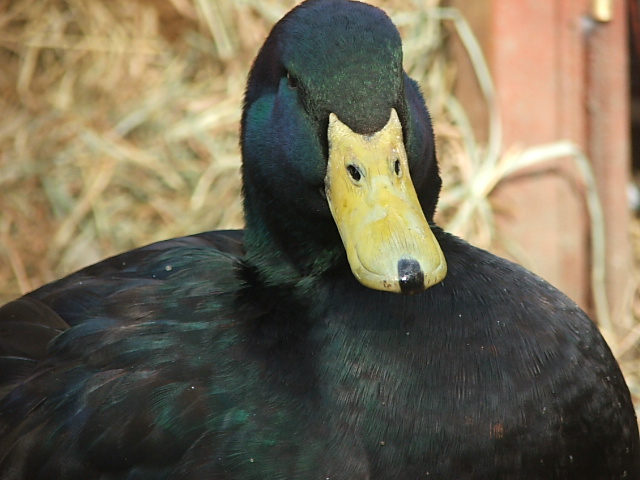
Jeffrey
soaks up some sun
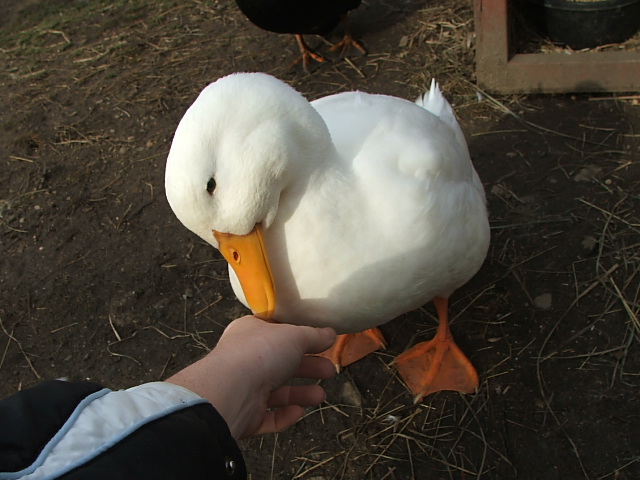
A kiss from Matthew...
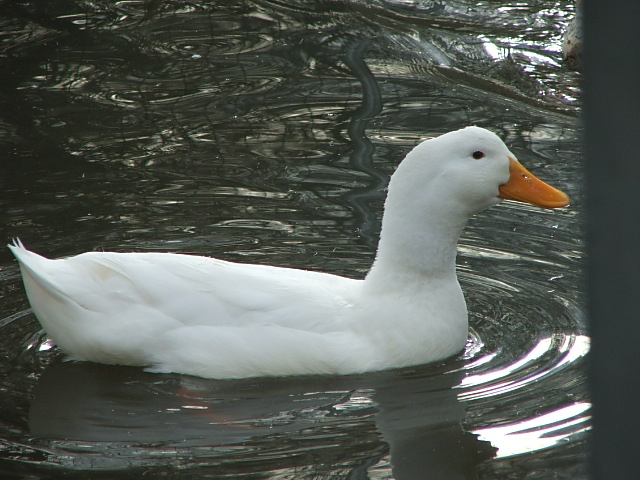
Elijah enjoys a quiet
swim...
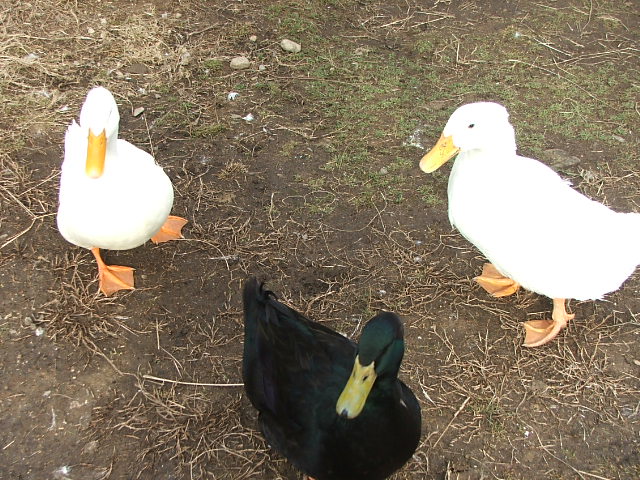
Do you
have any snacks for us?
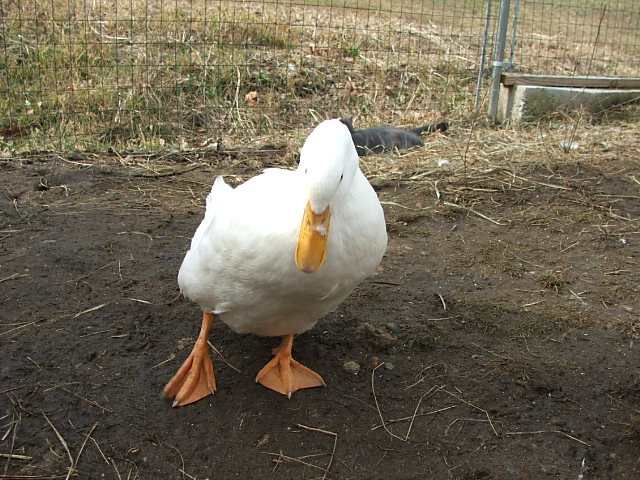
Deirdre
takes a bow!
Get to Know
Your Predators:
The Northern Pike
Yes, even a fish
can be dangerous. The Northern Pike weighs in around eight
pounds. Pike lurk in the water,
in the vegetation near shore, and they have been known to
eat ducklings.
Your best defense is to
keep your ducklings off of water inhabited by the Northern Pike.
Recommended
Reading*
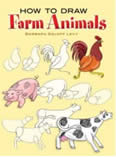
|
Ordering
information
|
How to
Draw Farm Animals
By Barbara Soloff Levy
This
easy-to-follow guide makes it a snap for any aspiring artist to draw
everyone's favorite barnyard buddies. Step-by-step diagrams use
circles, ovals, and other geometric shapes to create images of a
turkey, duck, horse, cow, and 26 other farm animals.
|
* |
For
our full recommended reading list, click
here. If you order from
Amazon by way of our website, Majestic receives a
portion of the proceeds!
|
Reader Poll
#25
Question:
What would you like to accomplish in 2007? (Check as many as
you like.)
Results of Reader Poll #24
What do you
think about those resin/plastic geese you dress in seasonal
outfits and place on your porch or hearth?
|
They are SO charming! |
38% |
|
I own one and love it! |
8% |
|
I wish I had one! |
31% |
|
They are SO ridiculous! |
23% |
Contact Us
Majestic Waterfowl
Sanctuary
17 Barker Road
Lebanon, CT 06249
directorATmajesticwaterfowl.org
Our Newsletter
The Majestic Monthly is published 12 times per year. Back
issues can be obtained online from our
Newsletter Archives.
|
Loss of Appetite
in Waterfowl
When your duck
or goose is suffering from a loss of appetite, a vet visit is in
good order. Ducks and geese tend to hide their ailments for as
long as they can as a defense against predation. If a predator
sees a sick or weak bird, it will target it, so a duck or
goose’s best defense is often a good act. Loss of appetite can
be indicative of a camouflaged health problem. Verify if your
duck or goose has any other symptoms. Diarrhea commonly
accompanies many ailments and can be a clear indicator. If your
bird’s stool seems normal, it is still wise to bring a sample
with you to the vet for screening. If negative for parasites,
many vets will place your bird on five day round of a general
antibiotic (often Baytril 22 mg, 1 pill daily) to address any
hidden infections.
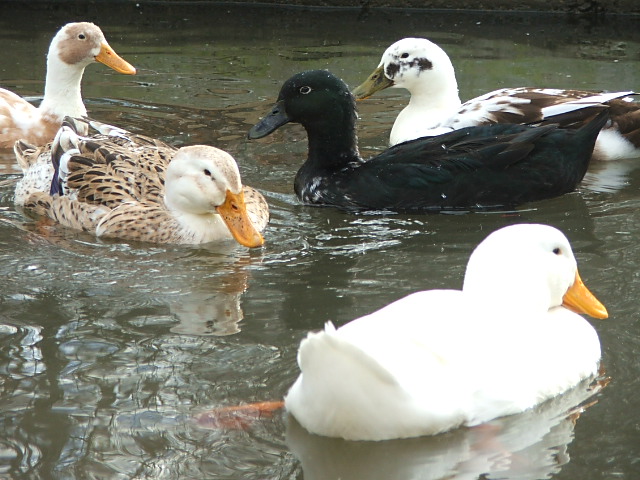 Loss of
appetite can also occur when hens are nesting. If you notice
this and have no intention of hatching out ducklings or
goslings, remove the eggs and completely disperse the nest.
Continue to do this daily until your hen abandons the nesting
behavior. If your hen is nesting, and you want her to, consider
putting food and water dishes next to her nest for easy
accessibility. If she still refuses to eat, you will need to
remove all eggs and completely dismantle her nest to discourage
her fasting behavior, which is extremely detrimental to her
health. Loss of
appetite can also occur when hens are nesting. If you notice
this and have no intention of hatching out ducklings or
goslings, remove the eggs and completely disperse the nest.
Continue to do this daily until your hen abandons the nesting
behavior. If your hen is nesting, and you want her to, consider
putting food and water dishes next to her nest for easy
accessibility. If she still refuses to eat, you will need to
remove all eggs and completely dismantle her nest to discourage
her fasting behavior, which is extremely detrimental to her
health.
We have heard of ducks losing
their appetites when they are on inadequate diets. If your duck
or goose is not eating properly, an unhealthy diet can sometimes
be the issue. See our
October 2006 newsletter
for healthy dietary options.
We have
seen a loss of appetite in a duck who came to us infested with
lice. As soon as Daphnee came in, we noticed the culprits and
bathed and treated her with poultry delousing powder. Within
hours she was free of them (although we continued with a
treatment regime to address new hatchlings for an additional 14
days). Her appetite slowly returned to her, full force, within
two days of original treatment. See our
January 2006 newsletter for more
information regarding lice.
When you
notice a loss of appetite in your duck or goose, also consider
anything in their environment that may have changed. Temporary
and brief episodes of loss of appetite can occur during these
disturbances. Try to determine if your duck or goose may be
stressed by loud noise -- new construction taking place nearby.
Perhaps there is an object in visual range that is disturbing
them -- a tractor parked next to their pen that is usually not
there. Changes in the amount of light your birds are exposed to
can also lead to disturbances among your flock. Environment
changes can sometimes frighten routined pets, and disturb their
eating/sleeping cycles.
Loss of
appetite can also occur if you have a “bully” in your flock that
is preventing any other flock members from getting at food or
water sources. Making multiple food sources available may
resolve the issue, or separations may be in order.
Taming
Aggressive GeeseWhether you
are adopting geese or raising them up from goslings, you may
find yourself at the whim of a tyrannical alpha goose. We have
often been asked what we do in this situation and we have heard
success stories in response to our advice, so it’s time we share
with everyone. When Ali and Chan
first came to us last year, Ali was the alpha leader, and Chan
was his gentle subordinate. Within minutes of his arrival to the
sanctuary, Ali attempted to put me in my place with a good bite
and a pretty harsh wing beating. For our own future safety, I
had to set to the immediate task of establishing myself as his
alpha leader. It was vital that I didn’t fall into a subordinate
position at the get-go, setting the pace for future
interactions. The longer you are assigned to a subordinate
position, the more difficult it can be to reverse the role.
After my brief confrontation with Ali, I
waited for the two newcomers to settle back down, and then I
reentered the pen wearing protective clothing -- a thick winter
jacket, protective boots and thick gloves. Ali immediately ran
over to challenge me, but I stayed in place and raised my arms
out from my sides to make myself look bigger. I did not back
away, nor did I step forward. I stayed confident; I leaned
forward and mimicked the hissing sounds he made at me, being
sure that my sounds were a little more poignant than his.
He stopped a few feet in front of me, using
his better judgment and deciding that I might be too much for
him to tackle. After a few seconds of stand off, I took a slight
step forward, raising my knee into the air and slightly stomping
my one foot down on the ground. It was a very controlled and
precise movement. He held his ground and hissed again. I
repeated the action with my other foot as I stepped forward
again, and hissed at him with my arms still out at my sides -- like
big open wings. At one point he lunged forward and snapped at
me, but I quickly crossed my arms in front of me in a “genie
style” pose, which blocked his attempt. I leaned towards him
with my still-crossed arms, an action that forced him back a few
steps without me actually having to push him. My thick coat was
a safety buffer between my arms and his bill if I needed it. He
wasn’t expecting my fearlessness. He stood there hissing at me
for a moment (and I continued to hiss back) and then he
relinquished and took a step back.
I continued to take small steps towards
him, but decisive steps, with a good stomp to punctuate them. I
kept my eyes focused on his eyes. I did not show fear. He
stopped hissing and backed up again. I said, “I am in charge”
and meant it, “I am not afraid of you.” He turned away and
quickly moved to the other side of the pen with his pal Chan. I
stood in place, silent and still, for a minute and then backed
out of the pen. I stood outside of the closed pen door, looking
in at Ali for a moment, and then I walked away and gave him some
time to think. Over the course of
the next couple weeks, I entered their pen a few times a day and
went about my business with little regard for what they were
doing. I made it a point to walk near them, but I showed no
immediate interest in them. I would not just wander in the pen
aimlessly and walk about. I would assign myself a specific task
to accomplish before entering the pen; then, I would step inside
and go about doing it. When my task was complete, I would leave
the enclosure. Tasks can be as simple as going into the pen to
refresh their hay, top off food dishes, or change out a water
source. You can also enter with the mindset that you will check
the sturdiness of every third fence post -- an imaginary task, but
any task will work, even if it’s just a sham.
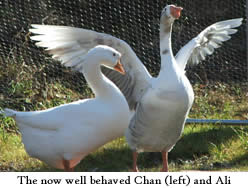
The attitude you want to exude when
entering the pen is one that is confident and determined. I say
the pen as opposed to their pen because you want to think of all
enclosures as belonging to you -- that’s part of this mindset. Be
careful not to be reckless or confrontational; avoid any fast or
jumpy movements. Stay in control, do not panic, and remain
relaxed -- never paranoid. Remember, you want to be their
protector; think of yourself this way when you enter. If you
seem nervous or frightened to them, they will not put their
trust in you. You must be the bravest in the flock in order for
them to relinquish their power to you and respect you.
Avoid looking at your geese when you are in
the pen; pretend instead that they are not even there (do keep
the alpha’s whereabouts subtly in mind though). Avoid focusing
on any subordinate geese who have nothing to prove. This can
actually draw a negative reaction from a protective alpha goose.
If you hear a goose coming toward you while
you are in the pen, turn quickly and confidently, raise your
arms out from your sides to make yourself bigger and hiss while
making eye contact. He should stop. If he does not back away
from you, then you will want to take a small step forward -- with a
small, but reaffirming stomp to the ground as your foot comes
down. A good trick is to wear an unzipped coat when you are
entering the pen. If your goose decides to challenge you, just
grab the bottom zipper corners of your coat in each of your
hands. When you lift your arms out to your sides your goose will
take your makeshift wings very seriously and will often back
down from his attack.
Be careful
not to take things too far. You want to establish yourself as a
trustworthy leader, not as a tyrant. You want their respect, not
their fear. As soon as the goose relinquishes their challenge
and moves away from you, you have done enough. There is no need
to chase the goose off. Stand still for a moment while he backs
off and then slowly go about your business again. If he comes at
you again, just repeat the same tactics.
Once you have displaced the alpha goose and
assumed the role for yourself, it will be time for you to become
friends with your geese. The attitude you exude during your
visits should slowly shift as your goal shifts. To prepare them
for your first visits, find a chair that will keep you at an
advantage when you are sitting in it (not too low to the ground
at first). Bring the chair out to their pen and leave it there.
Don’t sit in it; just leave it there empty to give them time to
get used to the new object. After a couple days, go ahead and
relax in it. Bring them a few healthy snacks and visit with
them. Chan seems to enjoy it when we mimic his little musical
honks. Do those things which put your geese at ease and you will
be on your way to a great relationship.
|

